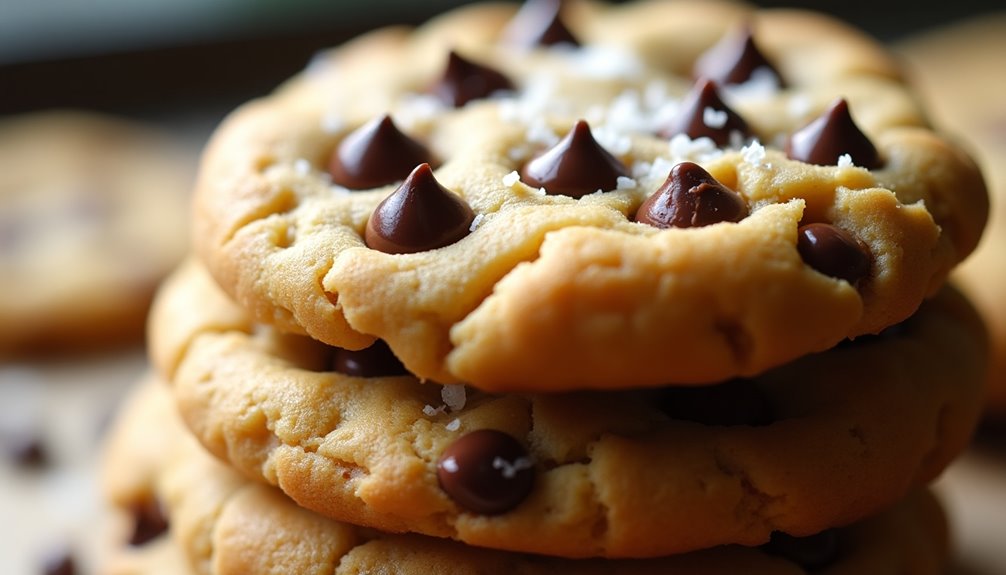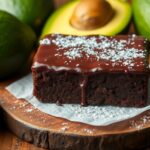You can enjoy gluten-free chocolate chip cookies that are just as delightful as traditional ones. Start by choosing the right flour, like almond or a gluten-free all-purpose blend. Don't forget binding agents like xanthan gum to improve texture. For extra flavor, try using semi-sweet or dark chocolate chips, and feel free to experiment with nuts or spices! Remember to chill your dough before baking; this helps achieve that chewy consistency everyone loves. By following a few simple steps, your cookies will impress anyone. There's more to explore about variations and storage tips that'll keep your baking vibrant!
Key Takeaways
- Use gluten-free all-purpose blends or alternative flours like almond or coconut flour for your cookie base.
- Incorporate binding agents like xanthan gum or psyllium husk to achieve the desired texture.
- For chewier cookies, chill the dough, use brown sugar, and consider adding an extra egg yolk.
- Experiment with different types of chocolate chips, nuts, or dried fruits for added flavor and variety.
- Store cookies in airtight containers, layering with parchment paper to maintain freshness.
Understanding Gluten-Free Ingredients
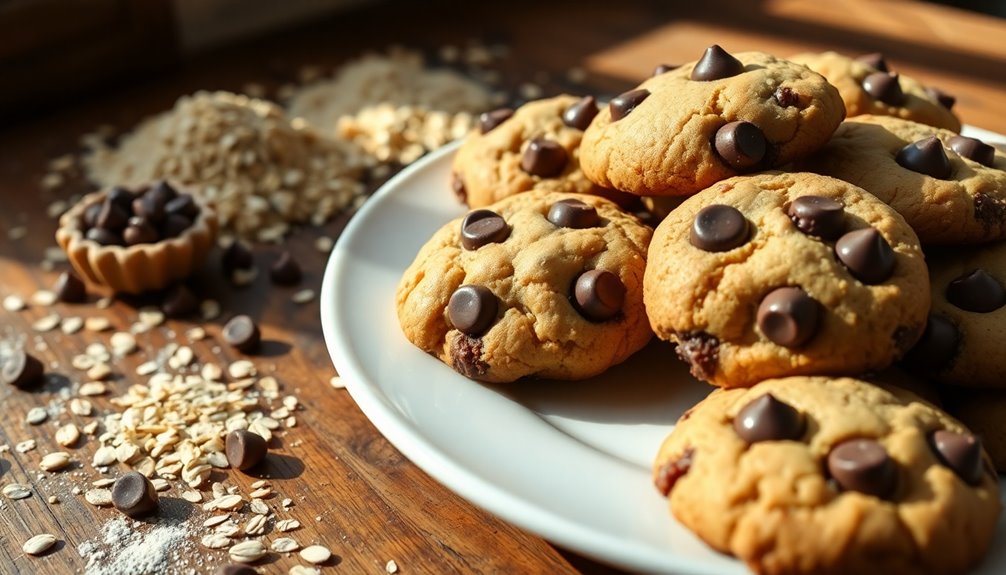
When it comes to baking gluten-free chocolate chip cookies, understanding the ingredients is essential to achieving that perfect texture and flavor. If you or someone you care about has gluten sensitivity, you know how crucial it's to select the appropriate substitutes. Instead of traditional wheat flour, you can explore options like almond flour, coconut flour, or gluten-free all-purpose blends. Each of these alternatives can yield delightful results, but they do behave differently in recipes.
When using gluten-free flours, bear in mind that ingredient substitutions may be necessary. For example, gluten-free flours often require additional binding agents, such as xanthan gum or psyllium husk, to replicate the elasticity gluten provides. These ingredients help produce that chewy texture you desire in a cookie.
Flavor is another aspect to ponder. While chocolate chips are a staple, you might want to experiment with different varieties, such as dark chocolate or dairy-free alternatives, to cater to various dietary preferences. Don't hesitate to incorporate nuts or dried fruit for an additional dimension of taste and texture.
It's all about finding the right balance so that everyone at your table can relish a warm, freshly baked cookie. Remember, baking gluten-free doesn't entail sacrificing flavor or enjoyment; it entails embracing creativity and inclusivity. With the correct knowledge, you'll be baking cookies that everyone can savor, and that feeling of belonging will shine through in every bite. Additionally, be aware that many gluten-free products can have high glycemic values, which may lead to unwanted health impacts similar to traditional wheat products.
Essential Baking Tools
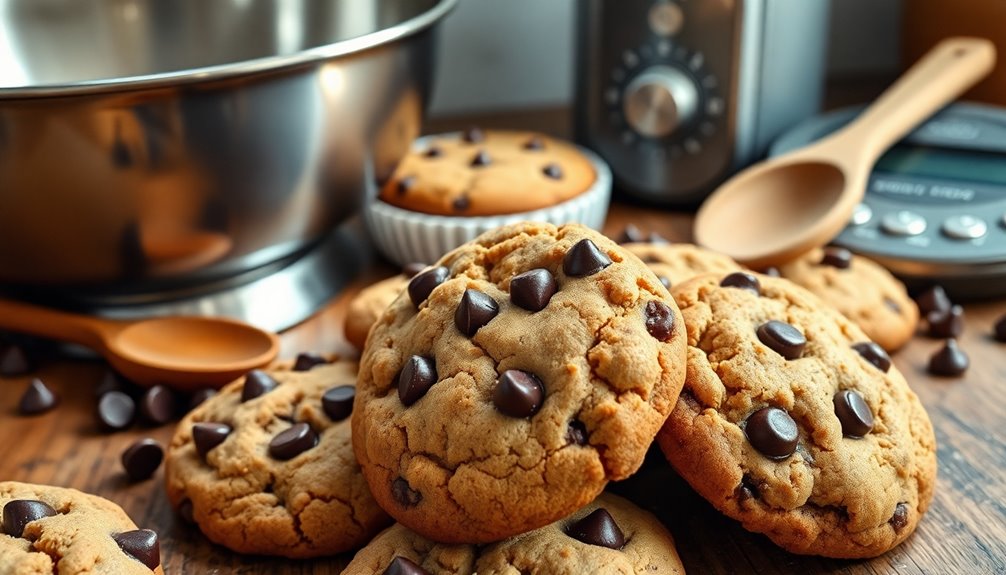
Baking gluten-free chocolate chip cookies requires the right tools to guarantee your efforts yield delicious results. Gathering essential baking tools not only makes the process smoother but also creates a sense of belonging in the kitchen community. You'll find that using the proper kitchen gadgets helps you feel more confident and connected to your baking journey.
Here's a list of baking essentials to keep handy:
- Mixing Bowls: A set of various sizes for combining your ingredients easily.
- Measuring Cups and Spoons: Accurate measurements are vital for the perfect cookie.
- Silicone Baking Mat: This non-stick surface makes for easy cleanup and prevents sticking.
- Cookie Scoop: Achieve uniform cookie sizes and make portioning a breeze.
- Cooling Rack: Essential for letting your cookies cool evenly after baking.
Having these tools at your fingertips means you're well-prepared to create mouthwatering gluten-free cookies that everyone can enjoy. Each gadget serves its purpose and helps you master your baking skills, making it easier to share your delicious treats with friends and family. Additionally, using the right tools can reduce joint pressure during the baking process, similar to how mini bands minimize strain in workouts.
Choosing the Right Flour
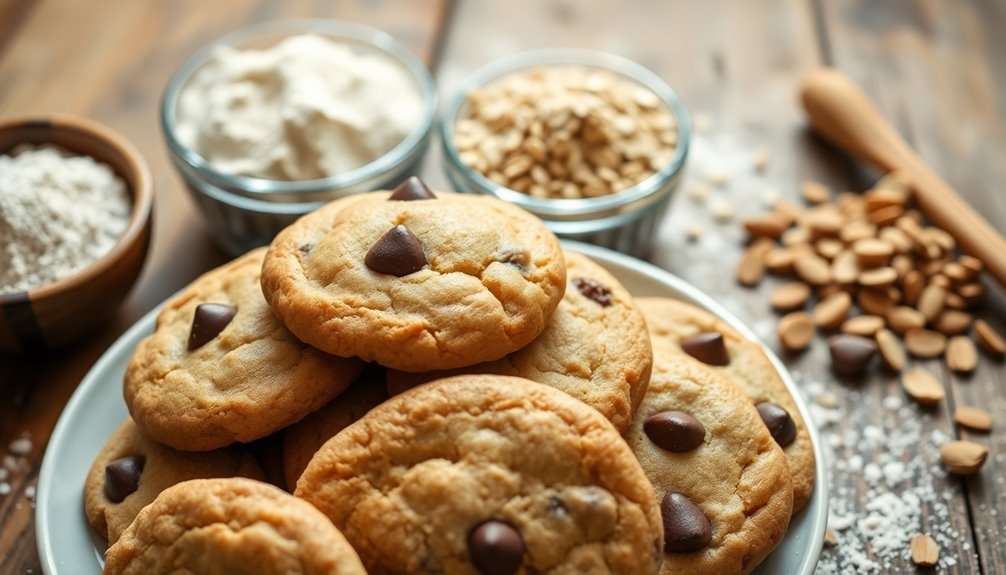
Choosing the right flour is essential for achieving the perfect texture and flavor in your gluten-free chocolate chip cookies. With so many flour alternatives available, it can feel overwhelming, but don't worry—you're not alone in this journey.
Each type of gluten-free flour brings its own unique properties to the table, so understanding your options will empower you to bake with confidence.
Almond flour, for example, is fantastic for adding a moist, rich flavor, while coconut flour is lighter and absorbs a lot of moisture, so you'll need to adjust your liquids when using it.
If you're aiming for a more traditional cookie texture, try a gluten-free all-purpose blend that usually combines several flour alternatives, like brown rice flour, tapioca starch, and xanthan gum. These blends often mimic the qualities of wheat flour, making them perfect for baking.
Don't forget about the importance of baking techniques, too! When using gluten-free flour, it's helpful to let your dough rest for about 30 minutes before baking. This allows the flour to hydrate fully and enhances texture. Additionally, consider adding a bit of cornstarch to your blend for a lighter, chewier cookie.
Interestingly, just like finding the right flour for your cookies, addressing snoring types may require tailored solutions based on individual needs.
As you experiment with these flour alternatives and techniques, you'll discover the perfect mix that resonates with your taste buds and brings everyone together. Happy baking—your gluten-free chocolate chip cookies are sure to be a hit!
The Perfect Chocolate Chips
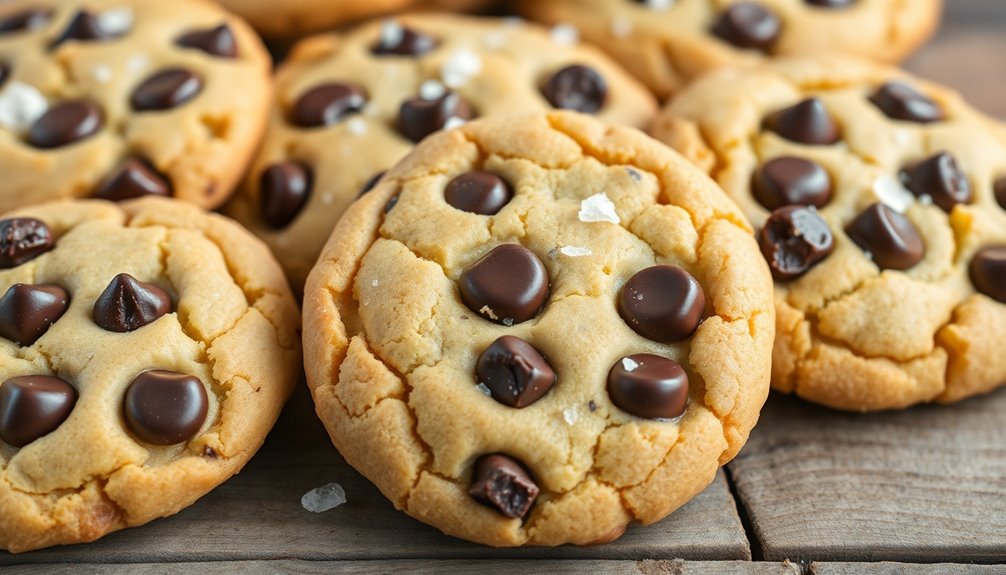
The right chocolate chips can elevate your gluten-free chocolate chip cookies from good to unforgettable. Choosing the perfect chips involves contemplating flavor combinations and texture preferences that align with your taste, making your cookies truly special. Whether you're baking for yourself or sharing with loved ones, the right chocolate chips can create a sense of belonging around the kitchen.
Here are some delightful options to ponder:
- Semi-Sweet Chocolate Chips: A classic choice, they balance sweetness with rich cocoa flavor.
- Dark Chocolate Chips: For those who enjoy a more intense chocolate experience, these add depth and sophistication.
- Milk Chocolate Chips: If you prefer a sweeter, creamier taste, milk chocolate will bring a smile to everyone's face.
- White Chocolate Chips: Adding a unique twist, they pair beautifully with nuts or dried fruits.
- Nutty or Flavored Chips: Think peanut butter or mint; these add an exciting layer to your cookies.
While you explore these options, remember to contemplate your texture preferences. Do you love a smooth bite or crave a bit of crunch? Mixing different types of chips can create a delightful contrast, enhancing each cookie's overall experience.
You'll find that each choice reflects your personality and tastes, creating a treat that's not just gluten-free but also full of warmth and connection. So go ahead, pick your favorite chocolate chips and get ready to bake some cookies that everyone will adore!
Step-by-Step Recipe
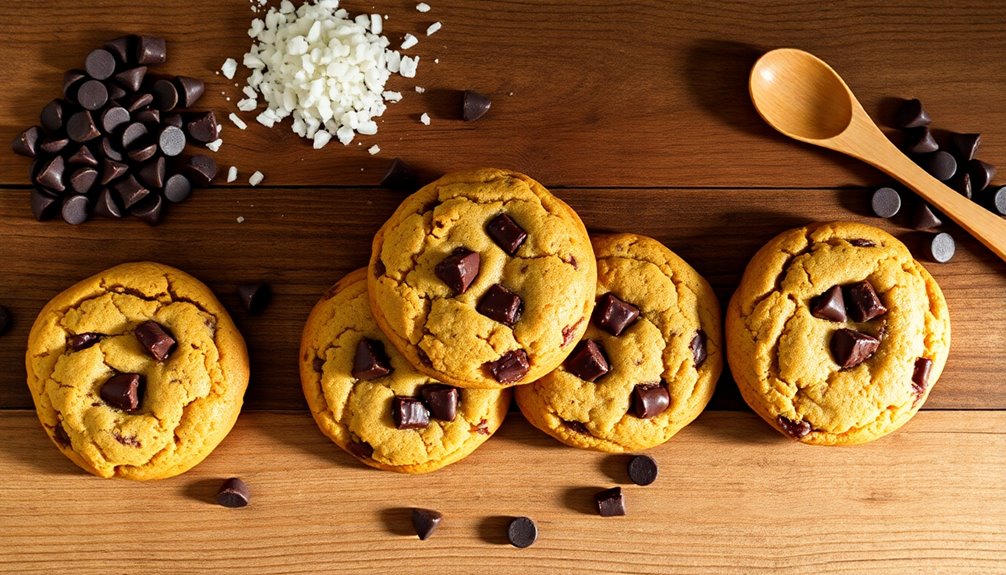
To create mouthwatering gluten-free chocolate chip cookies, you'll need to gather your ingredients and follow a simple step-by-step recipe. Start by preheating your oven to 350°F (175°C) and lining a baking sheet with parchment paper.
In a large mixing bowl, combine 1 cup of gluten-free flour blend, ½ teaspoon of baking soda, and a pinch of salt. This will be your dry mix.
In another bowl, cream together ½ cup of softened butter and ½ cup of packed brown sugar using your preferred mixing techniques, like a hand mixer or a whisk. Add in 1 large egg and 1 teaspoon of vanilla extract, blending until smooth. Gradually fold in your dry mix, ensuring everything's well incorporated.
Finally, stir in 1 cup of gluten-free chocolate chips, spreading them evenly throughout the dough.
Now, scoop tablespoon-sized portions of dough onto your prepared baking sheet, leaving space between each cookie. Bake them for about 10-12 minutes, keeping an eye on the edges, which should turn golden brown. Once they're done, let them cool on the sheet for a few minutes before transferring them to a wire rack.
Tips for Chewy Cookies
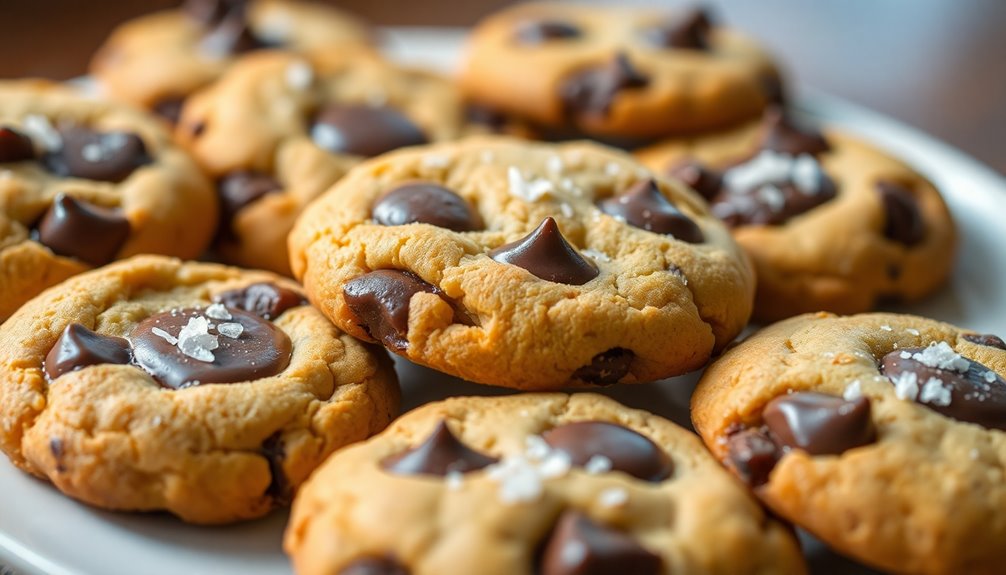
While achieving that perfect chewy texture in gluten-free chocolate chip cookies can be tricky, a few key tips can make all the difference. You'll want to focus on specific baking techniques and adjust your ingredients to cater to your texture preferences. Here are some essential tips to help you create those irresistibly chewy cookies:
- Use brown sugar: It adds moisture and a slight chewiness that white sugar just can't match.
- Chill the dough: Letting your dough rest in the fridge for at least 30 minutes helps prevent spreading and enhances the chewy texture.
- Reduce baking time: Take your cookies out of the oven when they're just slightly underbaked. They'll continue to firm up as they cool.
- Experiment with flour blends: A combination of gluten-free flours like almond and oat can provide a richer texture, while also enriching the flavor.
- Add an extra egg yolk: This additional fat can help create a more tender and chewy cookie.
Variations to Try
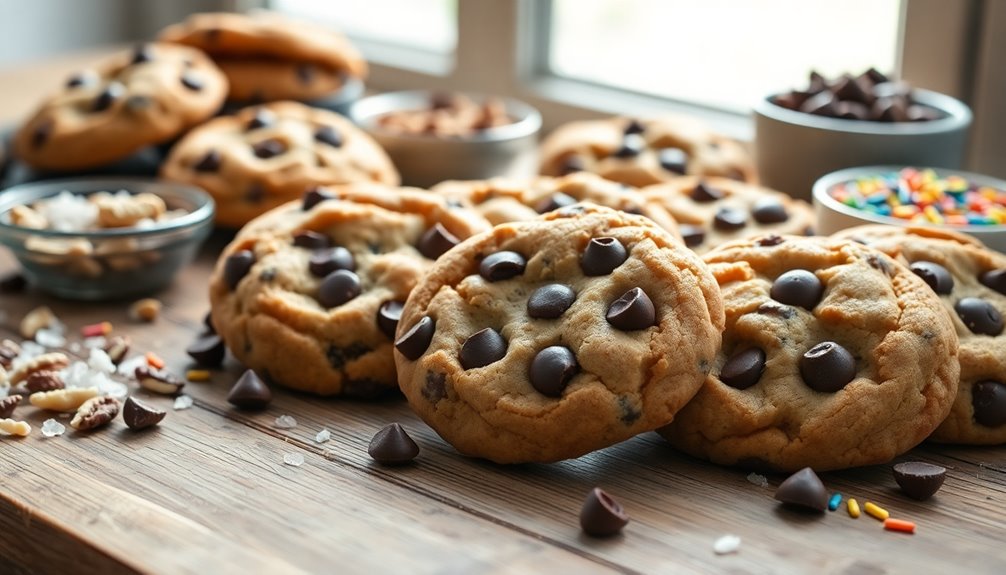
Exploring variations in your gluten-free chocolate chip cookies can elevate your baking game and cater to different taste preferences. You'll find that experimenting with flavor combinations can make your cookies stand out at any gathering.
For instance, try adding a pinch of cinnamon or a splash of vanilla extract for warmth. If you're feeling adventurous, incorporate orange zest or even a swirl of peanut butter for a delightful twist that everyone will love.
Texture experiments can also take your cookies to the next level. If you enjoy a bit of crunch, consider mixing in some chopped nuts or gluten-free oats. This not only adds a satisfying bite but also complements the gooey chocolate chips beautifully.
Alternatively, you can experiment with different types of chocolate—dark, milk, or even white chocolate can change the flavor profile entirely.
Don't forget about using different gluten-free flours! Almond flour or coconut flour can create a unique texture and flavor, making your cookies even more special. By mixing and matching these ingredients, you'll create gluten-free chocolate chip cookies that resonate with your friends and family, sparking conversations and creating lasting memories.
Storing Your Cookies
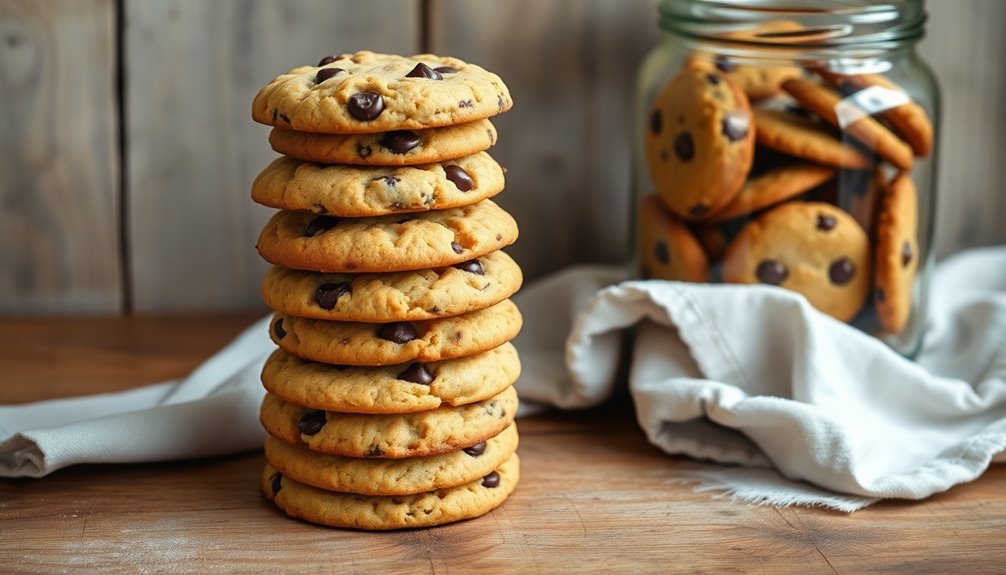
Properly storing your gluten-free chocolate chip cookies guarantees they stay fresh and delicious for as long as possible. Whether you've baked a batch for yourself or to share with friends, using effective preservation techniques will help you enjoy those cookies days or even weeks later. Here are some longevity tips to keep your treats in top shape:
- Cool completely: Let your cookies cool to room temperature before storing them to prevent moisture buildup.
- Use airtight containers: Choose containers that seal tightly to keep air out and maintain freshness.
- Layer with parchment paper: If you're stacking cookies, place parchment paper between layers to avoid sticking.
- Refrigerate for longer life: If you want to extend your cookies' shelf life, consider storing them in the fridge, especially if you live in a warm climate.
- Freeze for future enjoyment: For even more longevity, freeze your cookies in a single layer, then transfer them to a freezer-safe bag. They can last for up to three months!
Baking for Special Occasions
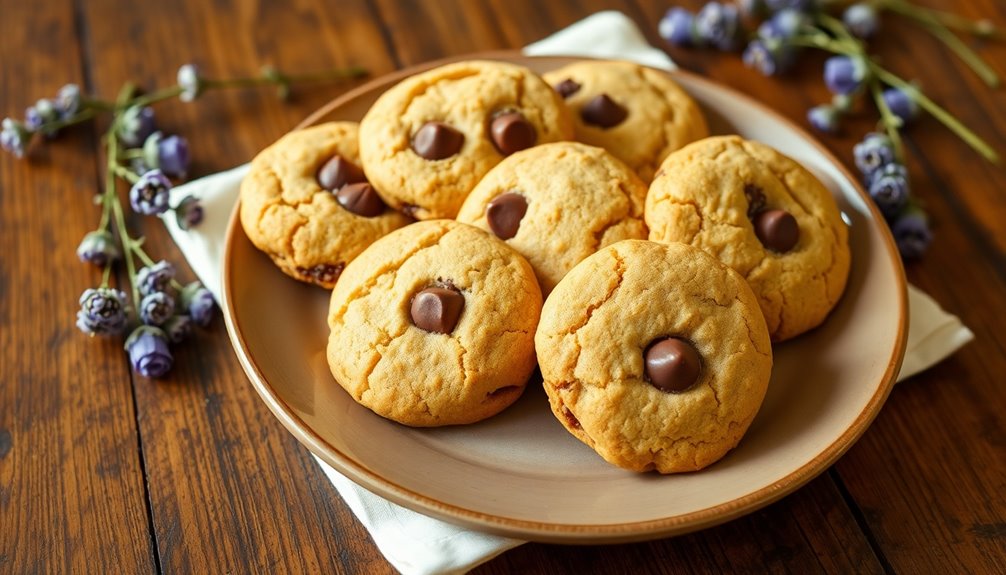
Baking gluten-free chocolate chip cookies for special occasions can be a delightful way to share your love for both baking and your guests. Whether it's a birthday celebration or a holiday party, these cookies can make everyone feel included, especially those who need to avoid gluten. The joy of watching friends and family indulge in your treats fosters a sense of belonging that's hard to replicate.
When planning for a birthday celebration, consider personalizing your cookies. You can add colorful sprinkles or even shape them into fun designs that match the party theme. This little touch not only enhances the visual appeal but also shows your guests that you truly care about making their day special.
For holiday parties, you can get creative by incorporating seasonal flavors like cinnamon or nutmeg into your cookie dough. Imagine the delightful aroma filling your home as these cookies bake, bringing everyone together. Set up a cookie decorating station for your guests; it's a fun way to engage everyone and create lasting memories.
Benefits of Going Gluten-Free
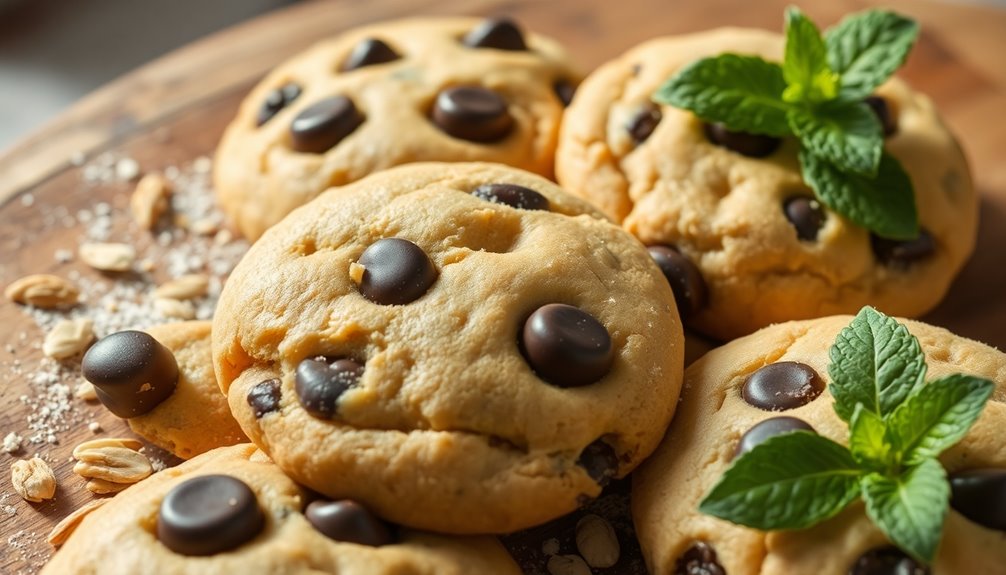
Choosing to go gluten-free can offer numerous benefits, especially for those with gluten sensitivities or celiac disease. You might find that this dietary shift not only alleviates uncomfortable symptoms but also enhances your overall well-being. Embracing a gluten-free lifestyle can create a sense of community, as you connect with others who share similar dietary restrictions.
Here are some key health benefits you may experience:
- Improved Digestion: Many people report fewer digestive issues when eliminating gluten from their diet.
- Increased Energy Levels: Without the fatigue that often accompanies gluten consumption, you might feel more energized and focused.
- Reduced Inflammation: A gluten-free diet can help minimize inflammation in the body, leading to less pain and discomfort.
- Better Nutritional Choices: Going gluten-free encourages you to explore a variety of whole foods, promoting a healthier diet overall.
- Enhanced Mood: Some individuals notice a positive shift in their mood and mental clarity when they stop consuming gluten.
Frequently Asked Questions
Can I Substitute Butter With Oil in Gluten-Free Cookies?
Yes, you can substitute butter with oil in your baking. When you do, you might notice a difference in texture; oil typically results in a denser consistency. However, experimenting with different oils can introduce unique flavor variations, enhancing your treats.
Just remember to adjust your baking techniques slightly; you may need less oil than the butter amount. Embrace the process, and you'll create delicious cookies that everyone can enjoy!
How Long Do Gluten-Free Cookies Stay Fresh?
Did you know that cookies can stay fresh for about a week at room temperature? To keep your gluten-free cookies tasting great, follow some baking tips and storage recommendations.
Store them in an airtight container to maintain their moisture and flavor. If you want them to last longer, consider freezing them; they can stay fresh for up to three months.
Enjoy your delicious treats, knowing they'll stay delightful for your gathering!
Are Gluten-Free Chocolate Chip Cookies Healthier?
When you're wondering if gluten-free chocolate chip cookies are healthier, it really depends on the ingredients. They can have a different nutritional value compared to regular cookies, often relying on alternative flours.
While some might argue they offer a lighter texture, others find the taste less satisfying. Baking time might vary, too.
Ultimately, if they fit your dietary needs and you enjoy them, they can be a delicious treat in moderation!
What Can I Use Instead of Eggs in the Recipe?
If you're looking to replace eggs in your recipe, you've got some great vegan options! Try using unsweetened applesauce or mashed bananas as a binder.
You can also mix flaxseed meal with water for a perfect egg substitute. These allergy-friendly alternatives not only make your dish inclusive for everyone but also keep it delicious.
Embrace these choices, and you'll create something everyone can enjoy together!
Can I Freeze Gluten-Free Cookie Dough?
Absolutely, you can freeze cookie dough! It's a great way to save time for future baking. Just scoop your dough onto a baking sheet, freeze them for a couple of hours, then transfer the frozen balls into a freezer-safe bag. When you're ready to bake, you can pop them straight into the oven. Keep these baking tips in mind for best results, and enjoy those delicious treats whenever you want!
Conclusion
In the delightful world of gluten-free baking, you've discovered that simple ingredients can create extraordinary treats. Who would've thought that swapping flours could lead to such mouthwatering chocolate chip cookies? As you savor each bite, you'll realize that this journey not only caters to dietary needs but also sparks creativity in the kitchen. With every batch, you're not just baking; you're crafting memories that coincide with flavors, proving that gluten-free doesn't mean compromising on taste or joy.

